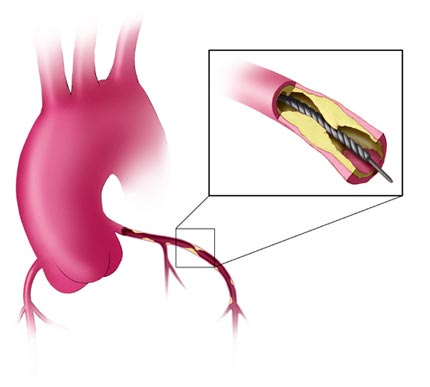Percutaneous Transluminal Angioplasty with Stent

What is percutaneous transluminal angioplasty?
Percutaneous transluminal angioplasty is a minimally invasive procedure used to open a blocked artery.
Why would I need PTA?
Peripheral artery disease (PAD) sometimes known as peripheral vascular disease (PVD), is a blockage of arteries in a limb, usually the leg. The blockage is most often the result of a chronic buildup of hard, fatty material (atherosclerosis) inside the artery walls. This narrows the artery and prevents oxygen and nutrients from getting to the limb.
What can I expect during an PTA?
- The physician will make a small incision (cut) is made in the thigh, allowing access to the femoral artery.
- A guide wire is inserted into the artery.
- Under the guidance of X-ray video (fluoroscopy), the wire is threaded to the site of the blockage.
- A thin tube called a catheter sheaths the wire and is pushed to the blockage. The catheter has a small, collapsed balloon at its tip.
- The catheter enters the blockage, and the balloon is inflated, flattening the plaque against the artery walls.
- The balloon may be coated in medicine that helps the artery heal from this process with less scarring. This is called a drug-eluting balloon.
- The physician then collapses the balloon and withdraws the catheter.
- The physician may then perform stenting and/or atherectomy.
What is a stent?
A stent is a mesh tube placed inside an artery to hold it open. If performed, stenting takes place just after the angioplasty balloon is used.
How is the stent deployed?
The catheter is withdrawn from the artery, and its balloon tip is loaded with the collapsed stent. The catheter delivers the stent to the area of former blockage. The doctor inflates the balloon, causing the stent to expand. When the balloon is collapsed, the stent remains in place.The catheter and guide wire are removed.
The mesh of the stent may be covered in synthetic fabric. It may also be coated in medicine that helps the artery heal with less scarring. This is called a drug-eluting stent.
The procedure will take place under local anesthesia (numbing of the incision site).
Whether you stay in the hospital will depend on several factors, including your condition and other tests and procedures being done.
The physician will have specific orders about physical activity after you go home.
